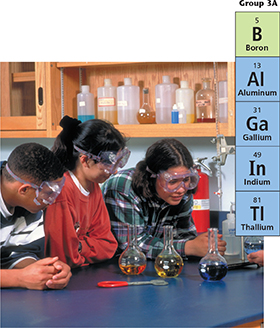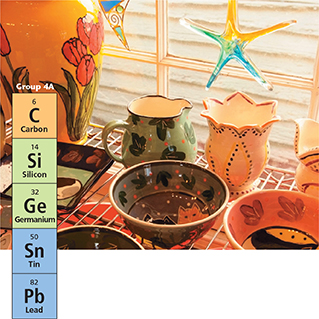The Boron Family
Group 3A contains the metalloid boron, the wellknown metal aluminum, and three less familiar metals (gallium, indium, and thallium). All these elements have three valence electrons.
 Aluminum is the most abundant metal in Earth's crust. It is often found combined with oxygen in a mineral called bauxite (BAWKS eyet). Aluminum is less reactive than sodium and magnesium. It is strong, lightweight, malleable, and a good conductor of electric current.
Aluminum is the most abundant metal in Earth's crust. It is often found combined with oxygen in a mineral called bauxite (BAWKS eyet). Aluminum is less reactive than sodium and magnesium. It is strong, lightweight, malleable, and a good conductor of electric current.
More than 10 percent of the aluminum produced is used as packaging. Some aluminum is used in window screens, window frames, and gutters. Parts of cars and airplanes are also made from aluminum. People are encouraged to recycle aluminum because the energy needed to purify recycled aluminum is only about 5 percent of the energy needed to extract aluminum from bauxite.
A compound of boron, silicon, and oxygen is used to make a type of glass that does not shatter easily when it undergoes a rapid change in temperature. Glass that contains boron is used to make laboratory glassware, such as the flasks in Figure 17. It is also used in cookware that can go directly from the oven to the refrigerator.
Figure 17 These students are using flasks made from glass that contains boron. This type of glass does not shatter as easily as glass without boron.

Figure 18 The clay used to make this pottery contains compounds called silicates. These compounds always contain silicon and oxygen. They usually contain aluminum and often contain other elements such as iron.

The Carbon Family
Group 4A contains a nonmetal (carbon), two metalloids (silicon and germanium), and two metals (tin and lead). Each of these elements has four valence electrons. Notice that the metallic nature of the elements increases from top to bottom within the group. In keeping with this trend, germanium is a better conductor of electric current than silicon.
Life on Earth would not exist without carbon.  Except for water, most of the compounds in your body contain carbon. Reactions that occur in the cells of your body are controlled by carbon compounds. Carbon and its compounds are discussed in Chapter 9, Carbon Chemistry.
Except for water, most of the compounds in your body contain carbon. Reactions that occur in the cells of your body are controlled by carbon compounds. Carbon and its compounds are discussed in Chapter 9, Carbon Chemistry.
Silicon is the second most abundant element in Earth's crust. It is found as silicon dioxide in quartz rocks, sand, and glass. The clay used to produce the pottery in Figure 18 contains silicon compounds called silicates. Silicon carbide, a compound of silicon and carbon, is extremely hard. Saw blades tipped with silicon carbide last many times longer than ordinary steel blades.





 Which Group 3A element is a nonmetal?
Which Group 3A element is a nonmetal?